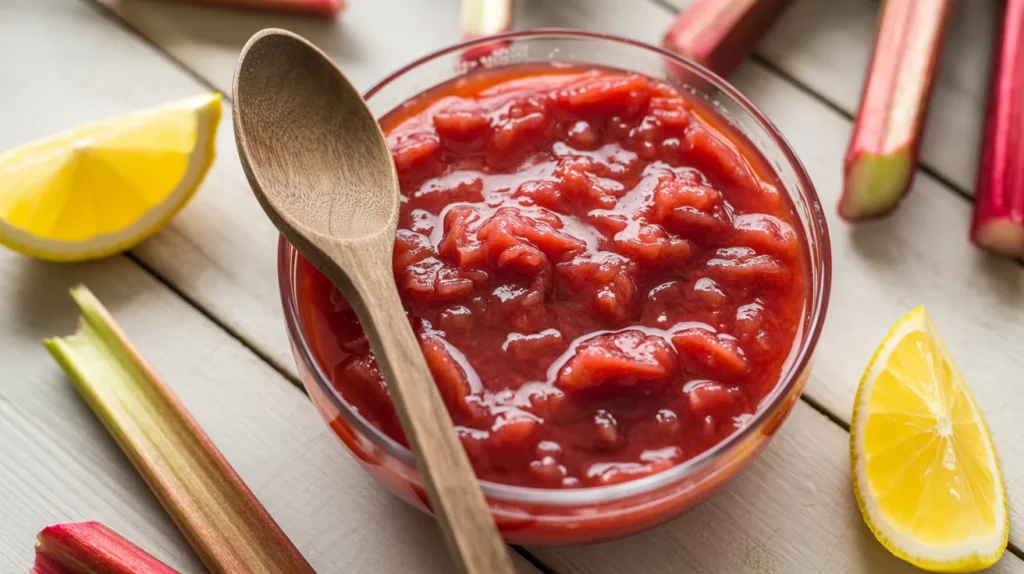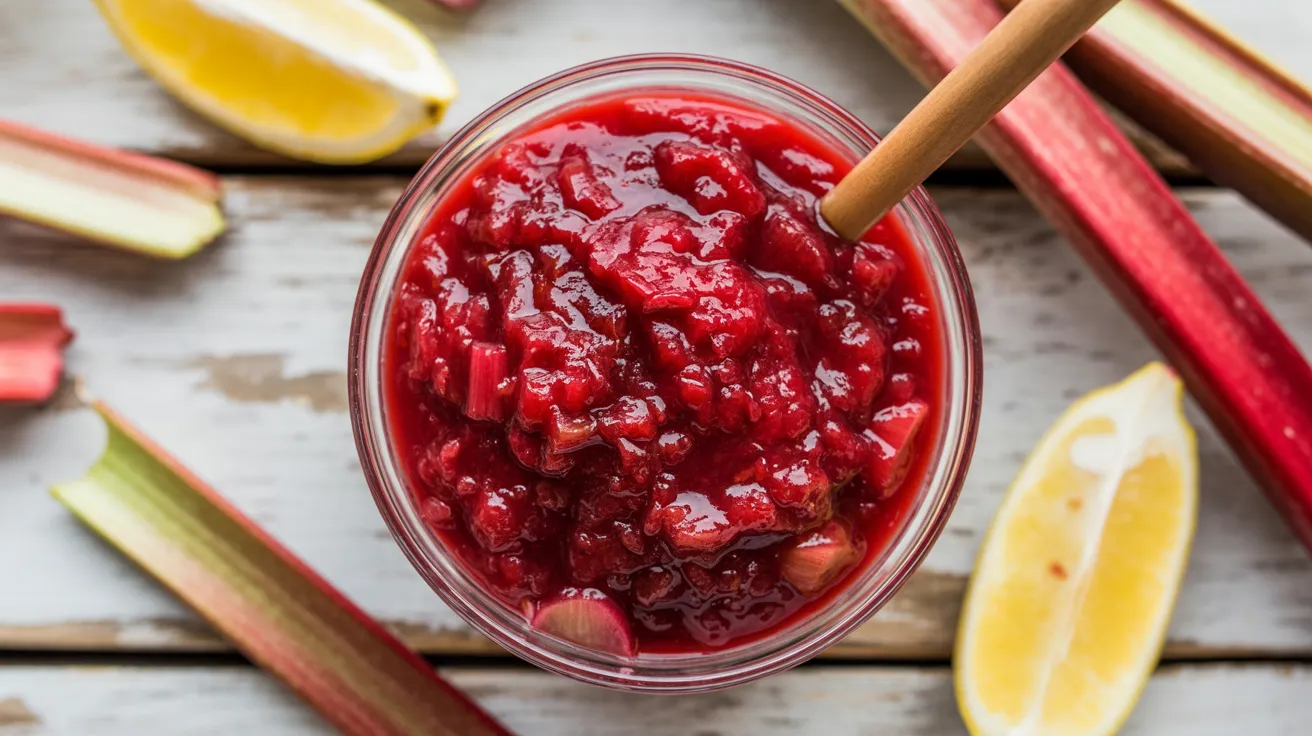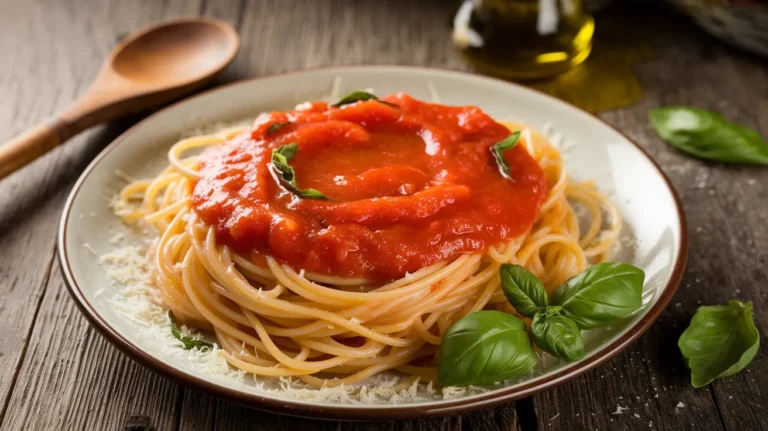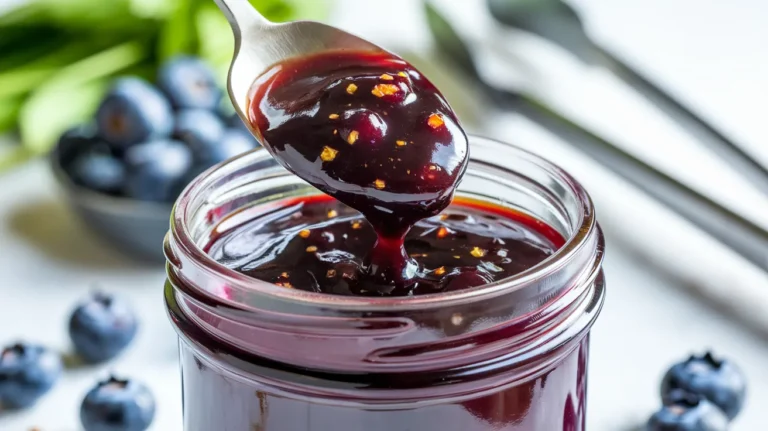This vibrant rhubarb sauce transforms tart garden stalks into a ruby-red culinary gem that’s surprisingly simple to master. Our detailed rhubarb sauce recipe guides complete beginners through every step, creating the perfect balance of sweet and tangy flavors that will elevate your desserts, breakfasts, and even savory dishes.
Recipe Info Bar
SERVES: 4 | PREP: 20 MIN | COOK: 25 MIN | TOTAL: 45 MIN
Ingredients
Main Components
| Ingredient | Amount | Notes |
|---|---|---|
| Fresh rhubarb stalks | 2 pounds | Choose firm, bright-colored stalks |
| Granulated sugar | 3/4 cup | Start with this, adjust to taste |
| Water | 1/4 cup | Prevents initial sticking |
| Fresh lemon juice | 2 tablespoons | Brightens flavor and preserves color |
| Pure vanilla extract | 1 teaspoon | Adds depth and warmth |
Optional Flavor Enhancers
- Ground cinnamon (1/2 teaspoon)
- Fresh orange zest (1 tablespoon)
- Minced fresh ginger (1 teaspoon)
Detailed Step-by-Step Rhubarb Sauce Instructions
Phase 1: Preparation and Setup (15 minutes)
Step 1: Inspect and select your rhubarb carefully Look at each stalk individually. Good rhubarb should feel firm like a celery stalk when you squeeze it gently. The color can range from green to deep red—both work perfectly for rhubarb sauce. Avoid any stalks that feel bendy, have brown spots, or look dried out at the ends. If you see any leaves attached, remove them immediately and discard—rhubarb leaves contain oxalic acid and are toxic if eaten.
Step 2: Clean your rhubarb thoroughly Fill a large bowl with cold water. Place all rhubarb stalks in the water and swish them around gently. Use your hands to rub off any dirt or debris stuck to the stalks. Lift each stalk out and inspect it—you might see strings or fibrous parts that need attention. Pat each stalk completely dry with paper towels or a clean kitchen towel.
Step 3: Trim the rhubarb properly Place each stalk on your cutting board. Using a sharp knife, cut off about 1/2 inch from both the top and bottom ends—these parts are often tough or dried out. If you notice any brown or dark spots along the stalks, cut those sections out completely. These spots can make your rhubarb sauce taste bitter.
Step 4: Cut rhubarb into uniform pieces This is crucial for even cooking. Cut each stalk into pieces that are exactly 1 inch long. Use a ruler if you’re not confident in your measuring skills. Why 1 inch? Smaller pieces (like 1/2 inch) will break down completely and create a mushy sauce. Larger pieces (like 2 inches) won’t cook evenly and might leave you with some mushy parts and some tough parts in your finished sauce.
Step 5: Measure all ingredients precisely Get out all your measuring tools. Measure the sugar into a small bowl—this makes it easier to add gradually later. Measure the water into a measuring cup. Squeeze your lemon and measure exactly 2 tablespoons of juice (strain out any seeds). Have the vanilla extract ready to measure. Preparing everything beforehand prevents mistakes when you’re focused on cooking.
Phase 2: Beginning the Cooking Process (10 minutes)
Step 6: Choose the right cooking pot Use a heavy-bottomed saucepan that holds at least 3 quarts. Heavy bottom means the metal is thick, which distributes heat evenly and prevents hot spots that could burn your sauce. If you only have a thin-bottomed pot, you’ll need to stir more frequently and use lower heat. Avoid non-stick pans for this recipe—the acidic rhubarb can react with the coating.
Step 7: Add rhubarb and water to the pot Place your cut rhubarb pieces in the cold saucepan first. Pour the 1/4 cup water over the rhubarb. The water serves two purposes: it prevents the rhubarb from sticking to the bottom before it releases its own juices, and it helps create steam for even cooking. Don’t worry—this small amount of water won’t make your sauce watery.
Step 8: Start with medium heat Turn your burner to medium heat—not medium-high, just medium. This gives you better control over the cooking process. Place the pot on the burner and don’t cover it with a lid. You want to be able to see what’s happening and allow moisture to evaporate as needed.
Step 9: Add sugar in three stages This is where many beginners make mistakes. Don’t dump all the sugar in at once. Instead, sprinkle about 1/3 of your measured sugar (roughly 1/4 cup) over the rhubarb pieces. Stir gently with a wooden spoon—wooden spoons won’t scratch your pot and won’t conduct heat like metal spoons do. The sugar will start drawing moisture out of the rhubarb immediately.
Step 10: Watch for the first signs of cooking Keep stirring every 30 seconds or so. After about 3-4 minutes, you’ll notice the rhubarb pieces starting to release juice. The mixture will look more liquid-like, and you might hear gentle sizzling sounds. This is exactly what you want—the rhubarb is beginning to break down and create its own cooking liquid.
Phase 3: Active Cooking and Development (15 minutes)
Step 11: Add remaining sugar gradually When you see good juice production (after about 5 minutes), add another 1/3 of your sugar. Stir it in completely. Wait another 2-3 minutes, then add the final portion of sugar. This gradual addition helps the rhubarb break down properly and prevents the sugar from caramelizing before the rhubarb is cooked.
Step 12: Bring to a proper simmer Increase heat slightly to medium-high. Watch carefully for bubbles to form around the edges of the pot—this happens before the center starts bubbling. Once you see consistent bubbling around the edges, you’ve reached a simmer. This should take about 2-3 minutes from when you increased the heat.
Step 13: Reduce heat immediately As soon as you achieve a full simmer (bubbles breaking the surface across the whole pot), reduce heat back to medium-low. The goal is to maintain gentle bubbling—if it’s bubbling vigorously, turn the heat down more. Aggressive boiling will make your rhubarb break down too quickly and can cause sticking or burning.
Step 14: Simmer with careful attention Now comes the main cooking phase. Set a timer for 15 minutes. Stir every 2-3 minutes with your wooden spoon. Use a scraping motion along the bottom of the pot to prevent sticking. You’ll notice the rhubarb pieces gradually getting softer and the liquid becoming more syrupy. The color will deepen from pale pink to a lovely ruby red.
Step 15: Test for doneness properly After 12-15 minutes of simmering, test a piece of rhubarb with a fork. It should pierce easily but the piece shouldn’t fall apart completely when you lift it. If it’s still firm, continue cooking for 2-3 more minutes. If the pieces are falling apart completely, your rhubarb sauce is done.
Step 16: Check consistency accurately Lift your wooden spoon out of the sauce and let it drip back into the pot. The sauce should coat the spoon lightly and drip off in a steady stream—not too thick like honey, but thicker than water. Remember, the sauce will thicken more as it cools due to natural pectin in the rhubarb.
Phase 4: Finishing and Final Adjustments (5 minutes)
Step 17: Remove from heat completely Turn off the burner and move the pot to a cool burner or to a trivet on your counter. This stops the cooking process immediately and prevents overcooking while you make final adjustments.
Step 18: Add lemon juice at the right time Add the 2 tablespoons of lemon juice now, not during cooking. Adding acid too early in the cooking process can make the rhubarb break down too much. Stir the lemon juice in completely—you’ll notice the color brighten slightly and the flavor become more balanced.
Step 19: Add vanilla for depth Measure and add the 1 teaspoon of vanilla extract. Pure vanilla extract is worth the extra cost here—it adds complexity that artificial vanilla can’t match. Stir it in thoroughly.
Step 20: Taste and adjust sweetness This is crucial for perfect rhubarb sauce. Use a clean spoon to taste (never double-dip). The sauce should have a nice balance of tart and sweet—it should make your mouth water slightly but not pucker from sourness. If it’s too tart, add more sugar 1 tablespoon at a time, stirring and tasting after each addition. Remember, the sauce will taste slightly less sweet when it’s cold.
Chef’s Notes
Professional Tip #1: The secret to exceptional rhubarb sauce lies in choosing rhubarb at peak freshness. Stalks should snap crisply when bent—if they bend without breaking, they’re past their prime and will create watery sauce.
Professional Tip #2: Never rush the sugar addition process. Rhubarb’s tartness varies dramatically between varieties and growing conditions. What tastes perfect in one batch might need adjustment in the next.
Professional Tip #3: Your rhubarb sauce will continue thickening for up to 2 hours after cooking due to natural pectin activation. Don’t over-reduce while hot, or you’ll end up with overly thick sauce when cool.
Professional Tip #4: Save 1/4 of your cut rhubarb pieces to add during the last 3 minutes of cooking. This creates lovely texture contrast between completely broken-down rhubarb and tender but intact pieces.
Nutrition Box (Per Serving)
- Calories: 145
- Protein: 1g
- Carbohydrates: 37g
- Fat: 0g
- Fiber: 3g
- Sugar: 34g
- Sodium: 5mg
- Vitamin C: 15% DV
- Calcium: 8% DV
Creative Rhubarb Sauce Variations
Cinnamon-Spiced Rhubarb Sauce
Add 1/2 teaspoon ground cinnamon and 1/4 teaspoon nutmeg during Step 11. This warming spice blend transforms your sauce into the perfect complement for pork dishes, much like how our yakiniku sauce adds depth to grilled meats.
Berry-Enhanced Rhubarb Sauce
Replace 1/2 pound of rhubarb with fresh strawberries or raspberries, added during the last 5 minutes of cooking. The berries contribute natural sweetness and create a gorgeous sunset color.
Ginger-Orange Rhubarb Sauce
Include 1 tablespoon minced fresh ginger and 2 tablespoons fresh orange zest during Step 9. This bright, zesty combination works beautifully with Asian-inspired dishes, similar to how hoisin sauce brings complexity to stir-fries.
Honey-Sweetened Rhubarb Sauce
Replace granulated sugar with 1/2 cup honey, but add it after Step 17 when you remove from heat. Honey’s delicate flavor compounds break down under high heat, so this timing preserves its floral notes.
Storage & Reheating Your Rhubarb Sauce
Proper Refrigerator Storage
Cool your rhubarb sauce completely to room temperature before storing—this takes about 45 minutes. Transfer to clean glass jars or airtight containers, leaving 1/2 inch of headspace. Glass containers prevent flavor absorption and are easy to clean. Properly stored sauce keeps for 7-10 days refrigerated.
Freezer Storage Methods
Freeze rhubarb sauce in portion-sized containers for up to 8 months. Use freezer-safe containers with tight-fitting lids, leaving 1 inch of headspace for expansion. Label with contents and date. Ice cube trays work perfectly for small portions—freeze, then transfer cubes to freezer bags.
Reheating Instructions
Thaw frozen sauce overnight in the refrigerator. To reheat, place desired amount in a small saucepan over low heat, stirring frequently. Add 1-2 tablespoons water if the sauce seems too thick. Heat just until warmed through—don’t boil again, as this can break down the texture.
Make-Ahead Benefits
Rhubarb sauce actually improves after 24 hours as flavors meld and develop. Make it a day before you plan to serve for optimal taste. The sauce can be made up to 3 days ahead for special occasions.

Troubleshooting Common Rhubarb Sauce Problems
Problem 1: My sauce tastes too sour
Solution: Add granulated sugar gradually, 1 tablespoon at a time. Stir each addition completely and let it dissolve before tasting. Simmer for 1-2 minutes after each addition to integrate flavors. Some rhubarb varieties are naturally more tart and need extra sweetening.
Problem 2: The sauce turned brown instead of staying pink
Solution: This usually happens from overcooking or using older rhubarb. While you can’t restore the color completely, add 1 tablespoon fresh lemon juice to brighten it slightly. Next time, use fresher rhubarb and cook at lower temperature.
Problem 3: My sauce is too watery and won’t thicken
Solution: Continue simmering uncovered, stirring frequently, until more liquid evaporates. The natural pectin in rhubarb needs time and gentle heat to activate. If it’s still thin after 30 minutes total cooking time, mix 1 teaspoon cornstarch with 2 teaspoons cold water and stir into the sauce.
Problem 4: All the rhubarb pieces disappeared completely
Solution: Your heat was too high, causing rapid breakdown. The sauce is still delicious but will have a smoother texture. Next time, use medium-low heat throughout cooking and reserve some rhubarb pieces to add during the last 5 minutes.
Problem 5: Sugar crystallized in my sauce
Solution: This happens from stirring too vigorously or adding sugar too quickly. Gently reheat the sauce with 2-3 tablespoons water, stirring minimally until crystals dissolve. Avoid over-stirring during the cooking process.
Essential Equipment for Making Rhubarb Sauce
Must-Have Tools
- Heavy-bottomed 3-quart saucepan (prevents scorching)
- Wooden spoon for stirring (won’t scratch or conduct heat)
- Sharp chef’s knife for cutting rhubarb
- Large cutting board with good grip
- Liquid and dry measuring cups
- Measuring spoons set
- Fine-mesh strainer (for smooth sauce option)
Helpful Additional Equipment
- Kitchen scale for precise measurements (1 pound = 16 oz)
- Ladle for easy transferring
- Glass storage jars or containers
- Timer to track cooking phases
- Instant-read thermometer (sauce is done at 180-185°F)
Complete Shopping List for Rhubarb Sauce
Produce Section
- 2 pounds fresh rhubarb stalks (choose firm, brightly colored ones)
- 1 large fresh lemon (for juice and potential zest)
- Fresh ginger root (if making ginger variation)
Baking/Pantry Aisle
- Granulated white sugar (at least 1 pound bag)
- Pure vanilla extract (not imitation)
- Ground cinnamon (optional for spiced version)
Dairy/Refrigerated Section
- None required for basic recipe
Storage Supplies
- Glass jars or airtight containers for storing finished sauce
Five Success Secrets for Perfect Rhubarb Sauce
1. Select rhubarb like a professional Choose stalks that are firm, brightly colored, and free from blemishes. Field-grown rhubarb (available late spring through early summer) has more intense flavor than greenhouse varieties. The color doesn’t indicate ripeness—green stalks can be just as flavorful as red ones.
2. Master the heat control technique The difference between perfect and ruined rhubarb sauce often comes down to temperature control. Medium-low heat allows proper pectin development while preventing scorching. If you smell any burning aroma, immediately reduce heat and stir more frequently.
3. Time your ingredient additions precisely Add sugar gradually to allow proper breakdown of rhubarb fibers. Add acidic ingredients (lemon juice) only after cooking to prevent over-softening. Add vanilla after removing from heat to preserve its complex flavor compounds.
4. Test consistency when sauce is cool Hot rhubarb sauce will always seem thinner than it actually is. The natural pectin continues working as temperature drops, so test a small spoonful that’s been cooled to room temperature for accurate consistency assessment.
5. Taste and adjust in layers Start with less sugar than you think you need—you can always add more, but you can’t remove it once dissolved. Taste after each adjustment and wait 30 seconds for flavors to integrate before deciding if more sweetening is needed.
This comprehensive rhubarb sauce recipe transforms humble garden stalks into a versatile culinary masterpiece that beginners can master with confidence. The detailed instructions ensure success every time, while the natural tartness of rhubarb creates a sauce that perfectly balances sweet and sour flavors. Whether spooned over vanilla ice cream, stirred into yogurt, or served alongside roasted meats, this rhubarb sauce adds vibrant color and bright flavor to any dish it accompanies.




